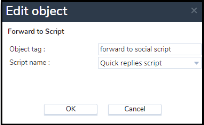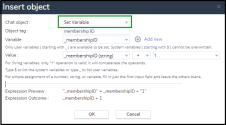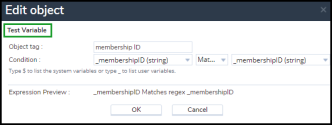| Schedule |
Use the Schedule object to perform a particular sequence of script operations when the contact center is either open or closed.
Parameters:- In the Label text entry area, type the alphanumeric label used to uniquely identify the element in the IVR script.
- Labels can contain a maximum of 21 characters, and must be unique within a script.
- In the Select schedule list, choose a schedule definition.
Exit points:
The Schedule object uses the Select schedule value to transfer control to the script sequence specified within the following exit points:- open equals true if the phone interaction has been received within the selected schedule's open hours.
- close equals true if the phone interaction has been received outside the selected schedule's open hours.
- #1 through #6 equal true if the schedule specified in Select Schedule includes an exception condition, numbered 1 through 6, and today's date is within the exceptions from and to dates.
For details on creating schedules, refer to Define Business Hours and Schedules. |
| Skip Queue |
Use this object to give the customers the option to opt out of waiting in the chat queue and send an email offline. This option can only be triggered in the greeting message object.- In the Object tag, type the alphanumeric label used to uniquely identify the element in the script. The object tag can contain a maximum of 21 characters, and must be unique within a script.
- Email Prompt Msg: The prompt message offered to a customer waiting in the chat queue. It can appear as a link in the chat window (for example, "All our agents are busy helping other customers. Would you like to send us an email?").
- Select form: Select an offline form from the list. An offline form presents an option to send an email message during the chat's offline hours.
- Send info by: Shows whether you want to send the information you collected in the form using an email channel or a dedicated email.
- Email channel: Select this option to choose an email channel. The email channel directs the customer's email to the right agent.
- Plain email: Select a dedicated email to send the customer's email to.
- Email Channel: If you choose to use a Channel, you must select an email channel from the list.
- Forced email header message: Specifies the Subject line in the email message sent by a customer skipping the chat queue.
Exit Point: None |
| Forward to Queue |
Use the Forward to queue object to forward a chat interaction to a specific chat queue, such as the sales or main queue.
Parameters:- In the Object tag, type the alphanumeric label used to uniquely identify the element in the script. The object tag can contain a maximum of 21 characters, and must be unique within a script.
- In the Queue name list, choose the target chat queue to receive the chat.
Exit points: None |
| CVB Online |
Chat Visual Block Online refers to a chat design element, such as a chat button or chat form which can be used on your website during business hours.
Parameters:- In the Object tag, type the alphanumeric label used to uniquely identify the element in the script. The object tag can contain a maximum of 21 characters, and must be unique within a script.
Exit points: None |
| CVB Offline |
Chat Visual Block Offline refers to a chat design element, such as a chat button or chat form that activates on your website during closed hours.
Parameters:- In the Object tag, type the alphanumeric label used to uniquely identify the element in the script. The object tag can contain a maximum of 21 characters, and must be unique within a script.
Exit points: None |
| CVB Default |
Chat Visual Block Default refers to a chat design element, such as a chat button or chat form available by default from 8x8 Contact Center.
Parameters:- In the Object tag, type the alphanumeric label used to uniquely identify the element in the script. The object tag can contain a maximum of 21 characters, and must be unique within a script.
Exit points: None |
| Greeting Message |
Use this object to type a greeting message to invite the customers to the chat session. Use @skipQueue@ to present the message that is previously set in the skip queue.
Parameters:- In the Object tag, type the alphanumeric label used to uniquely identify the element in the script. The object tag can contain a maximum of 21 characters, and must be unique within a script.
- In the Greeting Message, type the message you like to appear in the chat window. For example: <We will be with you shortly. click here to send an email.>
- Use auto-translation: This option is selected by default and is used to automatically translate the greeting messages using Google Translate. If this option is disabled, you can bypass the automatic translation, and let the user provide a customized translation instead.
Exit points: None |
| Test Condition of Queue |
Use the Test Queue object to check the condition of a queue before entering a queue. Test queue provides a set of conditions which, when met, trigger specified actions. The test queue object gives the IVR designer much more routing and announcement flexibility by allowing them to repeatedly test queue status.
Parameters:- In the Object tag, type the alphanumeric label used to uniquely identify the element in the script.
Labels can contain a maximum of 21 characters, and must be unique within a script. - In the Queue name list, choose the phone queue to test the condition.
- Use the Condition Matched check boxes to determine routing choices based on agent availability or queue performance.
- To route the chat differently, or to provide the customer with choices when there is no qualified agent available to immediately accept the interaction, select there are no enabled agents waiting.
- To route the chat differently, or to provide the customer with choices when there is no qualified agent logged in to immediately accept the interaction, select there are no assigned agents logged in.
Qualified agents refer to the agent setup to receive interactions from the queue specified in the Queue name list. - To evaluate the condition of a selected queue, and route the chat based on the test results of that performance, select Enable queue overload tests below.
Perform one or all of the following tests:- Number of chats in queue ahead of this chat: Enter the maximum number of chats that can be ahead of the current chat.
- there is a chat in this queue that has been waiting longer than (seconds): Enter the maximum time that a chat is waiting in the queue.
- the instantaneous expected wait-time calculation exceeds: Enter a time duration in seconds.
Exit points:
Test Queue has two exit points:- Condition Matched
- Condition not Matched
The Test Queue object transfers control to the script sequence specified under the exit points based on the following test results:- There are no enabled agents waiting in the queue.
- There are no assigned agents logged in.
- There are <n> number of chats in the queue ahead of this chat, where <n> is the number specified in the test.
- There is a chat waiting longer than the specified time in the queue.
- The instantaneous expected wait time calculation for a chat exceeds the specified time.
The expected wait-time calculation is useful only when there are more than 20 qualified agents assigned to the queue and active. Mathematical uncertainty with fewer than 20 active similarly-skilled agents may produce unexpected results.
Some of the many ways the exit points can be used are to trigger another test, provide the customer with a choice of waiting in a queue when no agent is available, leave a voicemail, or inform the customer of an approximate waiting time, and then forward to queue.
For example, if there is a chat in the queue that has waited longer than 120 seconds, you can insert the Play object under the Condition matched exit point to play a message informing the customer of an expected waiting time for the chat to be answered. You can then use the Forward to Queue object to route the call to a queue. |
| Chat as a Pop-up |
Allows the pop-up chat window to appear. The pop-up chat applies to the Pre-Chat Survey and the Chat Window options.
Parameters:- In the Object tag, type the alphanumeric label used to uniquely identify the element in the script. The object tag can contain a maximum of 21 characters, and must be unique within a script.
Exit points: None |
| Forward to Script |
Use it to forward a web chat interaction to a specific social script, such as the social script for quick replies.
Parameters:
Object tag: Type the alphanumeric label used to identify the script element uniquely. The object tag can contain a maximum of 21 characters and must be unique within a script.
Script name: Choose the social script to which the chat interaction will be forwarded. This list contains all social-media scripts from the Social page.
If both objects, Forward to queue and Forward to script, exist, Forward to script will have a higher priority. Thus, the Forward to queue object will be ignored.
Once the interaction has been forwarded to the social script, it will be able to use all of the nodes available in that social script. However, it will not be able to return to the web chat script.
Exit points: None.
|
| Set Variable |
The ability to set variables allows programming abilities within chat scripts, enabling better customer experience. You can use variables to remember the user input and use them to drive the chat flow. You can create variables to store values of string and number types and reference them anywhere and any number of times in the script.
8x8 Contact Center allows two types of variables in IVR:
- System Variables: These are predefined variables that cannot be edited:
- $language: Returns the currently used language.
- $vcaseNumber: Returns the case ID.
- $accountNumber: Returns the accountnumber.
- $emailAddress: Returns the customer’s email address.
- $emailSubject: Returns the customer’s email subject.
- $emailBody: Returns the customer’s email content.
- User-Defined Variables: These are variables defined by users.
You can initialize these variables with a specific value and modify them later.
Parameters:
Object Tag: Enter a label to identify the chat script element uniquely.
Variable: Select a predefined variable from the drop-down list or create a new variable. Only user variables ( starting with _ ) are available to be set. System variables ( starting with $ ) cannot be overwritten.
Value: Select a desired value for the variable.
For example, to offer customers suitable choices based on the queue position, set a variable and check:
- If the queue position is greater than 10, offer to call back when an agent is available.
- If the queue position is less than 10, play promotional messages and retain callers in the queue.
Exit Points: None
|
| Test Variable |
This object allows you to test an already defined variable and test it against a set value. To test a variable, select either a system or user-defined variable and test it against a specific value.
For example, test the membsershipID set for the customer using the user variable $MembershipID. If the language matches the system variable, then keep the customer in the queue; otherwise, it is not.
To access the Test Variable object within the script, click Add next to a node, and select the Test Variable object from the Insert Object list.
Exit Points:
- True: equals true if it meets the condition set for the variable.
- False: equals true If it does not meet the set condition.
|


